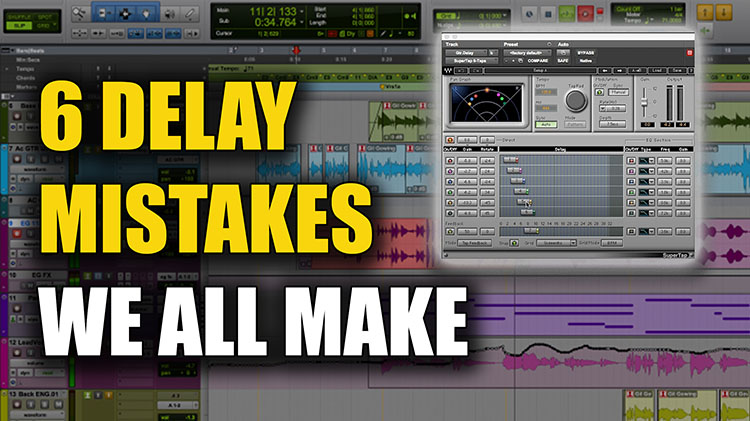This is going to be a fun one because we have talked about this in different forms, and I started thinking about it, and with delays, there really are no hard and fast rules. As such, creativity is king, but there are definitely some really big mistakes I have made over the years, so I want to try and cut that out for you, and cut to the chase!
Click here to download the 6 Delay Mistakes We All Make Cheat Sheet!
1. Not Knowing When to Use EQ on Delay
This is an interesting one, because for vocals, for instance, I don’t want to use an absolutely perfect facsimile, the most perfect digital thing ever, because if I do that, all that beautiful high end of the digital facsimile is going to give me double or triple T’s and S’s, and I don’t want that. So, this is where I go in and use EQ! Take your vocal delay and just gently EQ to get rid of some of that high end.
Now, the opposite is true when you are trying to get a facsimile, like when you are taking a guitar and you do want it to ping pong. This is where you will probably do less EQ, or maybe not at all.
2. Using a Delay When Reverb is a Better Fit
Does it always have to be a delay, or is a reverb really what you are looking for? Sometimes reverbs can be imagined as being millions and millions of tiny little delays causing this beautiful sound. And yes, of course, you can have 5 or 6 different delays all going at once to create this beautiful ambience around vocals or guitars. So, if you are sitting there dealing with 50 different delays to give you this sort of wash, which can be cool, but maybe just reach for a plate reverb to get the results you want.
Another thing you can do is put a reverb after the delay, and that might soften the impact of the delay, without you needing to use 5 delays. If you are ever unsure about what you should do, just experiment and see which tool gives you the results you want!
3. Having the Delay in Time or Not
It is really nice to have perfectly in time delays. This is quite often something you will apply to guitar parts. But sometimes you can have a delay that is not in time and achieve some great results. Use a delay that is perfectly in time to enhance rhythm, and use one that is not perfectly in time to do the opposite and make the part sit back in the track.
4. Panning of Delays
I have done it too many times where I think everything in my track must be in stereo and that if there is something on the left, it must be in balance on the right. This is true to a certain extent, but if you always have everything opposite, it starts to feel like there is no depth in the track. Don’t be afraid to put the delay underneath the instrument, and also try thinking about delay as a mono source as well as a stereo one!
5. Not Automating Your Delays
If you’ve got effects, automate them! I know that automation can take a bit of time, but that extra bit of detail and effort you put in doing automation on stuff will really help. These kinds of things making the mix so much more fun for the listener, and for us too, so don’t be afraid to use automation and have some fun with your delays!
6. Not Side Chaining Your Delays
If you are running lots of delays and reverbs and delays, which I frequently do on mixes, you can get into a trouble where you get it and it is audible, and it works some of the time. But a delay, in particular on something like a vocal, if it is too loud, it becomes kind of unusable, because what will happen is every time someone sings a phrase, the delay is underneath. However, at the end of a phrase, you might want that delay to be heard again, so how do you get around that? You set up a side chain compressor on the delay.
